HNN301: Suicide Prevention in Australia - Risk, Programs, and Nursing
VerifiedAdded on 2023/01/06
|12
|3469
|53
Report
AI Summary
This report provides a comprehensive overview of suicide prevention in Australia, examining the country's suicide rates, at-risk population groups, and the impact of suicide on individuals and communities. It delves into the risk and protective factors associated with suicide, highlighting the importance of understanding these elements for effective prevention strategies. The report then analyzes two key mental health promotion programs currently utilized in Australia: the National Suicide Prevention Advisor and the National Mental Health Strategy, evaluating their objectives and impact. Finally, it emphasizes the critical role of nurses in suicide prevention, underscoring their responsibilities in providing timely interventions and promoting mental health within the community. The report concludes by summarizing key findings and reinforcing the need for continued efforts in suicide prevention.

HNN301
Paraphrase This Document
Need a fresh take? Get an instant paraphrase of this document with our AI Paraphraser
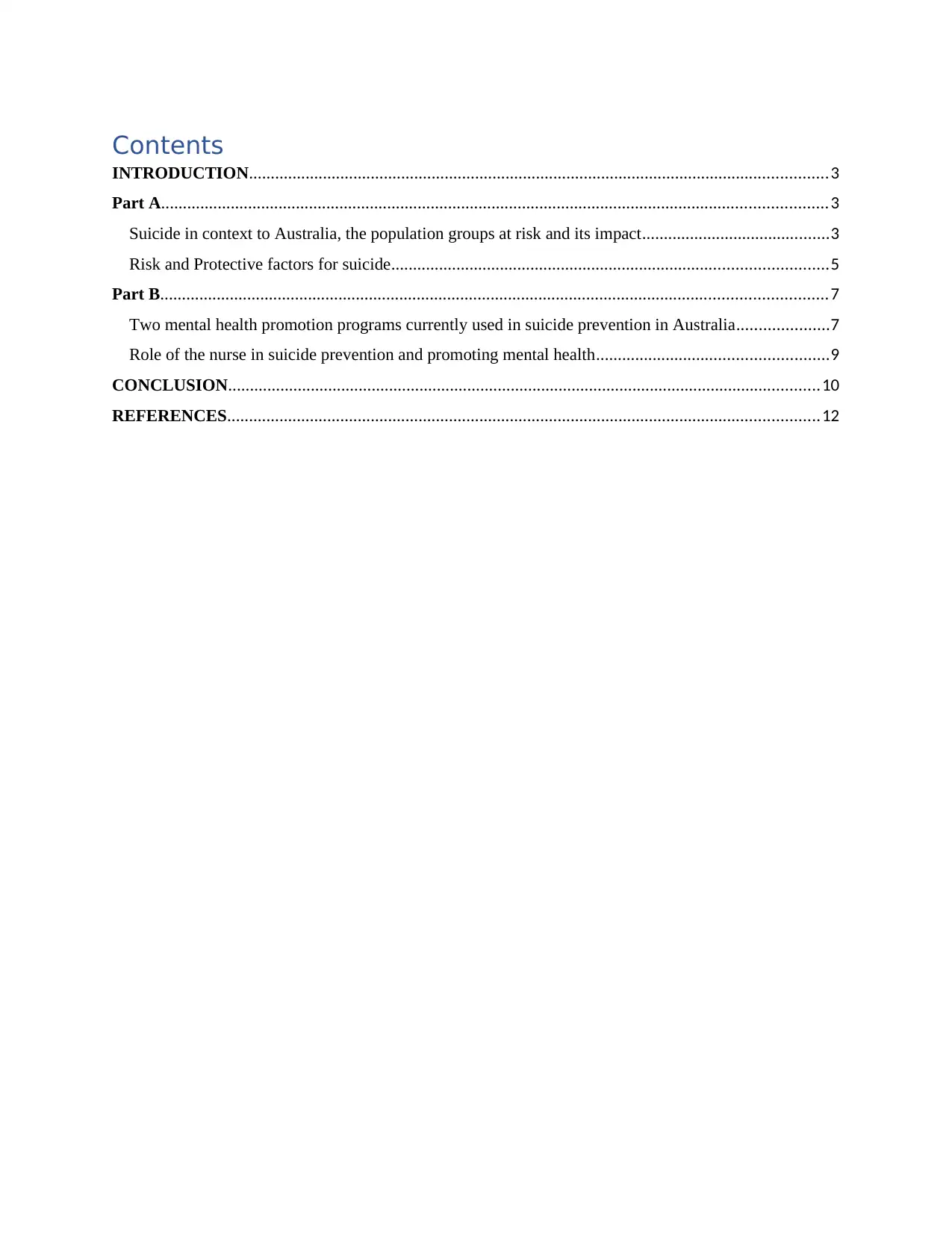
Contents
INTRODUCTION.....................................................................................................................................3
Part A.........................................................................................................................................................3
Suicide in context to Australia, the population groups at risk and its impact...........................................3
Risk and Protective factors for suicide....................................................................................................5
Part B.........................................................................................................................................................7
Two mental health promotion programs currently used in suicide prevention in Australia.....................7
Role of the nurse in suicide prevention and promoting mental health.....................................................9
CONCLUSION........................................................................................................................................10
REFERENCES........................................................................................................................................12
INTRODUCTION.....................................................................................................................................3
Part A.........................................................................................................................................................3
Suicide in context to Australia, the population groups at risk and its impact...........................................3
Risk and Protective factors for suicide....................................................................................................5
Part B.........................................................................................................................................................7
Two mental health promotion programs currently used in suicide prevention in Australia.....................7
Role of the nurse in suicide prevention and promoting mental health.....................................................9
CONCLUSION........................................................................................................................................10
REFERENCES........................................................................................................................................12
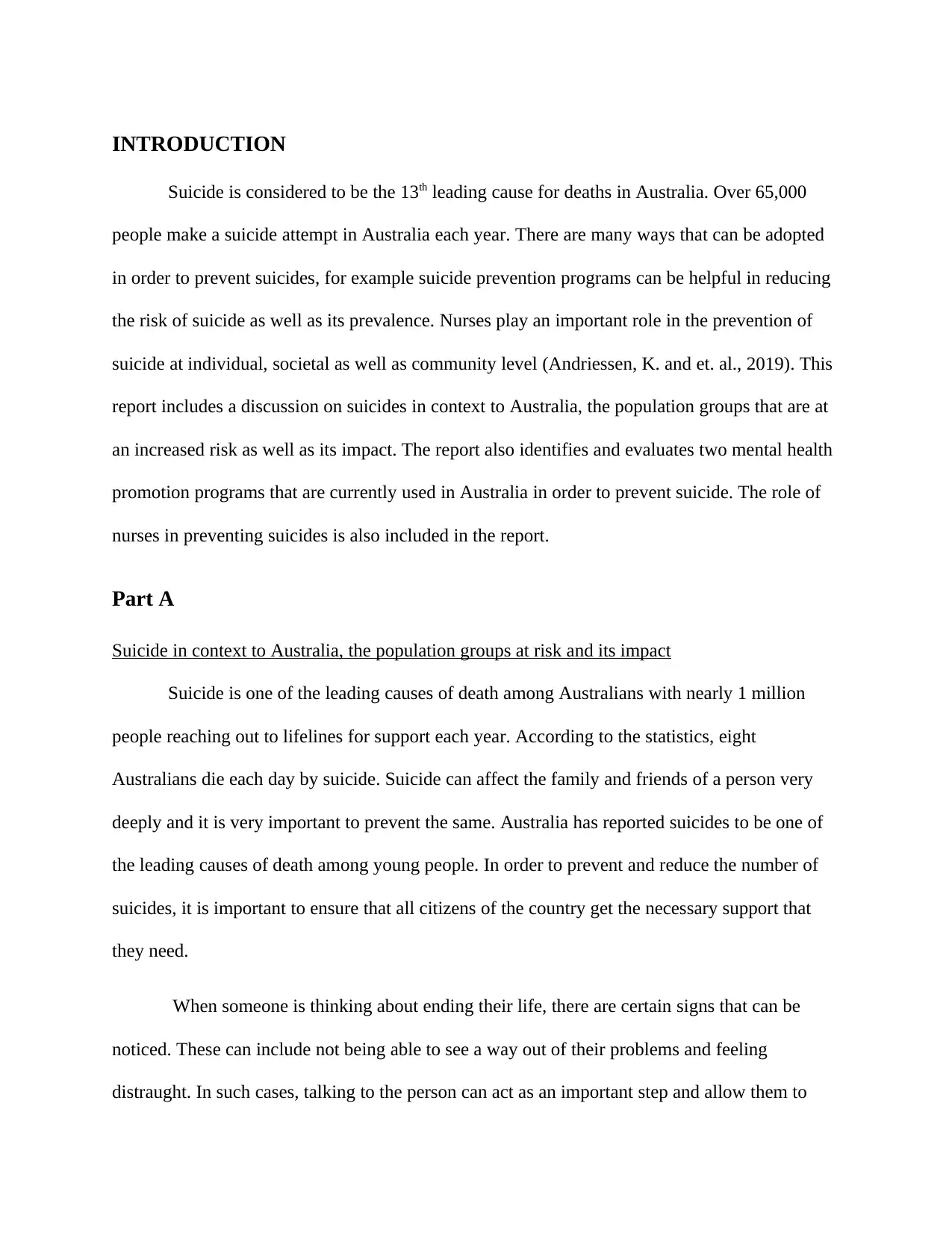
INTRODUCTION
Suicide is considered to be the 13th leading cause for deaths in Australia. Over 65,000
people make a suicide attempt in Australia each year. There are many ways that can be adopted
in order to prevent suicides, for example suicide prevention programs can be helpful in reducing
the risk of suicide as well as its prevalence. Nurses play an important role in the prevention of
suicide at individual, societal as well as community level (Andriessen, K. and et. al., 2019). This
report includes a discussion on suicides in context to Australia, the population groups that are at
an increased risk as well as its impact. The report also identifies and evaluates two mental health
promotion programs that are currently used in Australia in order to prevent suicide. The role of
nurses in preventing suicides is also included in the report.
Part A
Suicide in context to Australia, the population groups at risk and its impact
Suicide is one of the leading causes of death among Australians with nearly 1 million
people reaching out to lifelines for support each year. According to the statistics, eight
Australians die each day by suicide. Suicide can affect the family and friends of a person very
deeply and it is very important to prevent the same. Australia has reported suicides to be one of
the leading causes of death among young people. In order to prevent and reduce the number of
suicides, it is important to ensure that all citizens of the country get the necessary support that
they need.
When someone is thinking about ending their life, there are certain signs that can be
noticed. These can include not being able to see a way out of their problems and feeling
distraught. In such cases, talking to the person can act as an important step and allow them to
Suicide is considered to be the 13th leading cause for deaths in Australia. Over 65,000
people make a suicide attempt in Australia each year. There are many ways that can be adopted
in order to prevent suicides, for example suicide prevention programs can be helpful in reducing
the risk of suicide as well as its prevalence. Nurses play an important role in the prevention of
suicide at individual, societal as well as community level (Andriessen, K. and et. al., 2019). This
report includes a discussion on suicides in context to Australia, the population groups that are at
an increased risk as well as its impact. The report also identifies and evaluates two mental health
promotion programs that are currently used in Australia in order to prevent suicide. The role of
nurses in preventing suicides is also included in the report.
Part A
Suicide in context to Australia, the population groups at risk and its impact
Suicide is one of the leading causes of death among Australians with nearly 1 million
people reaching out to lifelines for support each year. According to the statistics, eight
Australians die each day by suicide. Suicide can affect the family and friends of a person very
deeply and it is very important to prevent the same. Australia has reported suicides to be one of
the leading causes of death among young people. In order to prevent and reduce the number of
suicides, it is important to ensure that all citizens of the country get the necessary support that
they need.
When someone is thinking about ending their life, there are certain signs that can be
noticed. These can include not being able to see a way out of their problems and feeling
distraught. In such cases, talking to the person can act as an important step and allow them to
⊘ This is a preview!⊘
Do you want full access?
Subscribe today to unlock all pages.

Trusted by 1+ million students worldwide
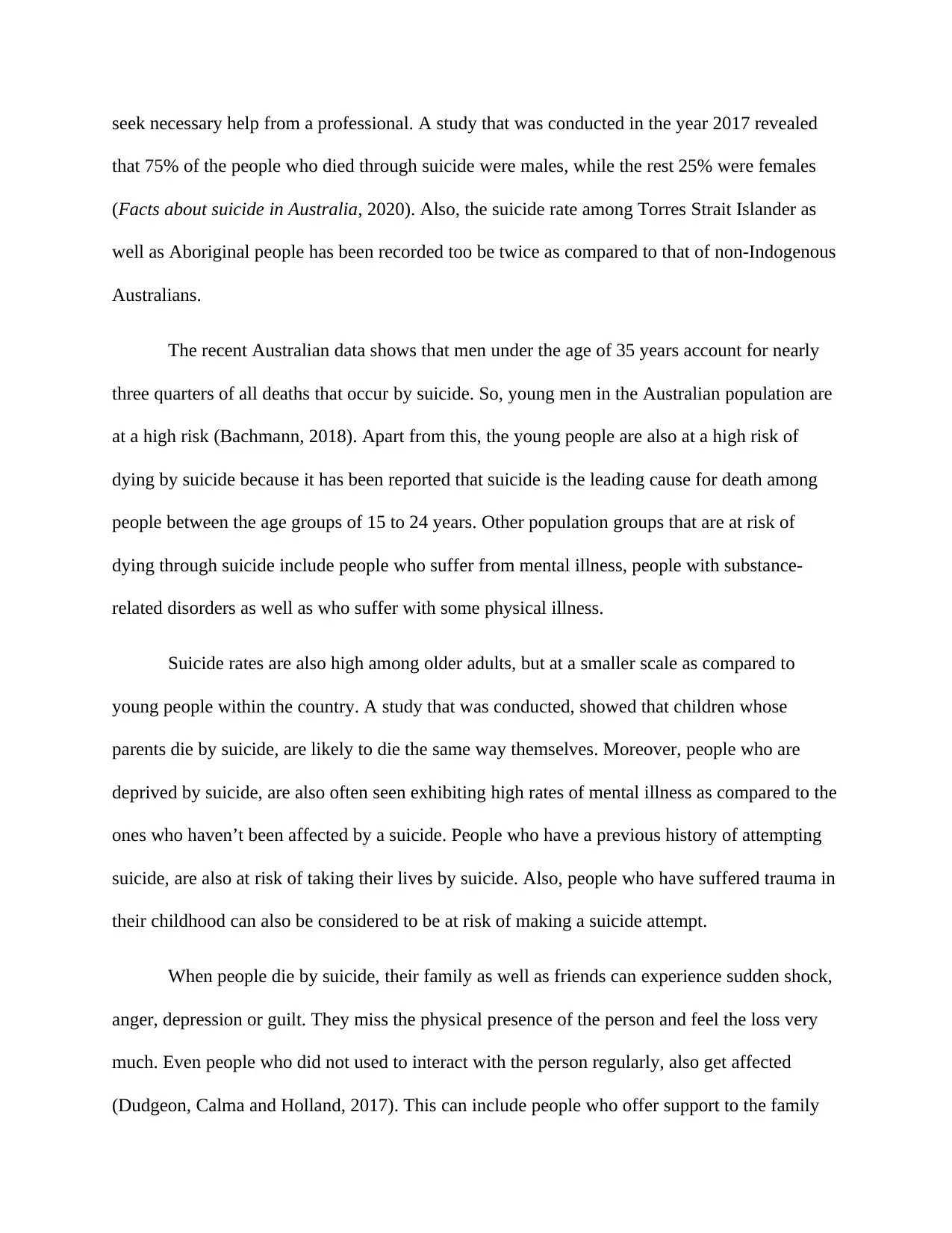
seek necessary help from a professional. A study that was conducted in the year 2017 revealed
that 75% of the people who died through suicide were males, while the rest 25% were females
(Facts about suicide in Australia, 2020). Also, the suicide rate among Torres Strait Islander as
well as Aboriginal people has been recorded too be twice as compared to that of non-Indogenous
Australians.
The recent Australian data shows that men under the age of 35 years account for nearly
three quarters of all deaths that occur by suicide. So, young men in the Australian population are
at a high risk (Bachmann, 2018). Apart from this, the young people are also at a high risk of
dying by suicide because it has been reported that suicide is the leading cause for death among
people between the age groups of 15 to 24 years. Other population groups that are at risk of
dying through suicide include people who suffer from mental illness, people with substance-
related disorders as well as who suffer with some physical illness.
Suicide rates are also high among older adults, but at a smaller scale as compared to
young people within the country. A study that was conducted, showed that children whose
parents die by suicide, are likely to die the same way themselves. Moreover, people who are
deprived by suicide, are also often seen exhibiting high rates of mental illness as compared to the
ones who haven’t been affected by a suicide. People who have a previous history of attempting
suicide, are also at risk of taking their lives by suicide. Also, people who have suffered trauma in
their childhood can also be considered to be at risk of making a suicide attempt.
When people die by suicide, their family as well as friends can experience sudden shock,
anger, depression or guilt. They miss the physical presence of the person and feel the loss very
much. Even people who did not used to interact with the person regularly, also get affected
(Dudgeon, Calma and Holland, 2017). This can include people who offer support to the family
that 75% of the people who died through suicide were males, while the rest 25% were females
(Facts about suicide in Australia, 2020). Also, the suicide rate among Torres Strait Islander as
well as Aboriginal people has been recorded too be twice as compared to that of non-Indogenous
Australians.
The recent Australian data shows that men under the age of 35 years account for nearly
three quarters of all deaths that occur by suicide. So, young men in the Australian population are
at a high risk (Bachmann, 2018). Apart from this, the young people are also at a high risk of
dying by suicide because it has been reported that suicide is the leading cause for death among
people between the age groups of 15 to 24 years. Other population groups that are at risk of
dying through suicide include people who suffer from mental illness, people with substance-
related disorders as well as who suffer with some physical illness.
Suicide rates are also high among older adults, but at a smaller scale as compared to
young people within the country. A study that was conducted, showed that children whose
parents die by suicide, are likely to die the same way themselves. Moreover, people who are
deprived by suicide, are also often seen exhibiting high rates of mental illness as compared to the
ones who haven’t been affected by a suicide. People who have a previous history of attempting
suicide, are also at risk of taking their lives by suicide. Also, people who have suffered trauma in
their childhood can also be considered to be at risk of making a suicide attempt.
When people die by suicide, their family as well as friends can experience sudden shock,
anger, depression or guilt. They miss the physical presence of the person and feel the loss very
much. Even people who did not used to interact with the person regularly, also get affected
(Dudgeon, Calma and Holland, 2017). This can include people who offer support to the family
Paraphrase This Document
Need a fresh take? Get an instant paraphrase of this document with our AI Paraphraser
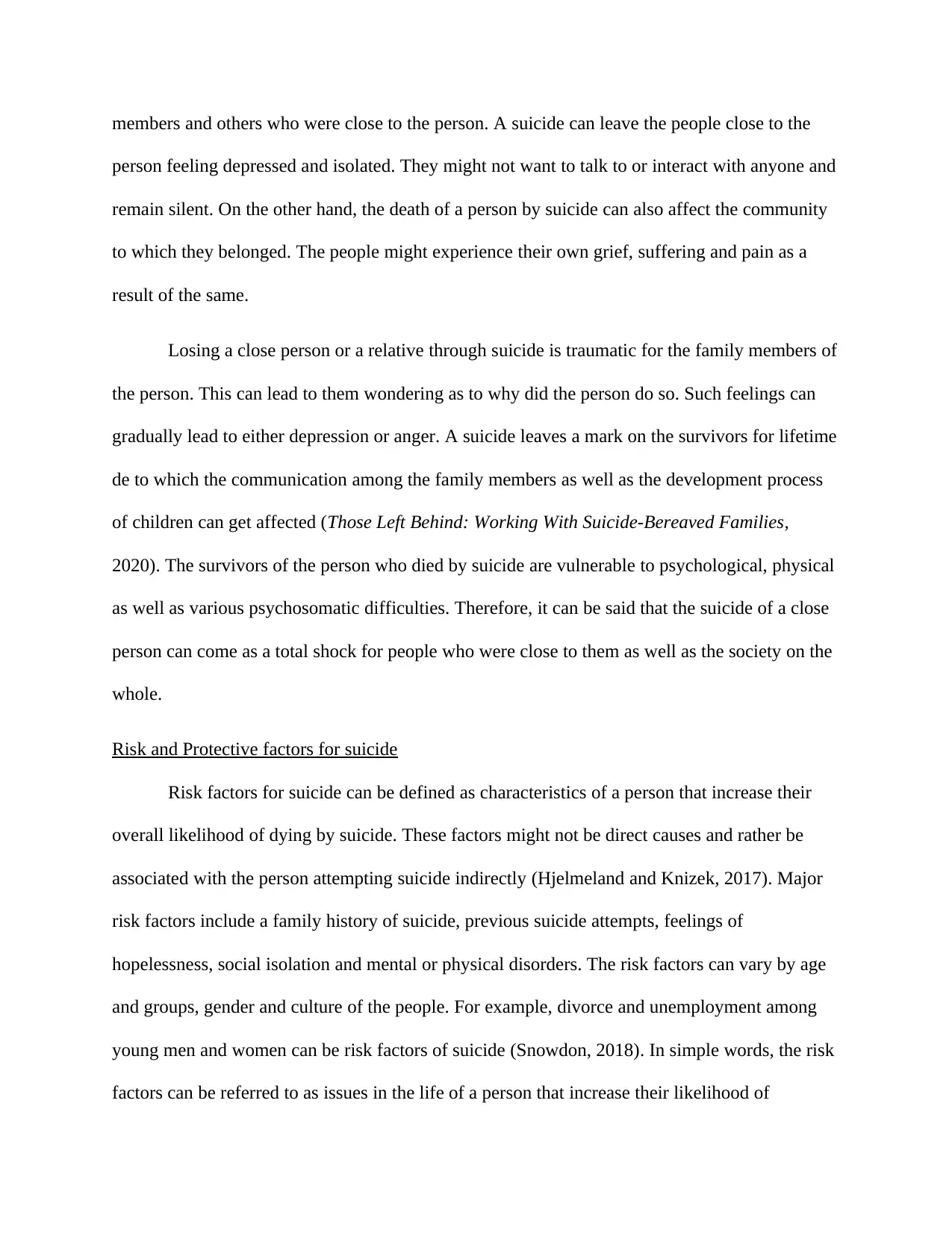
members and others who were close to the person. A suicide can leave the people close to the
person feeling depressed and isolated. They might not want to talk to or interact with anyone and
remain silent. On the other hand, the death of a person by suicide can also affect the community
to which they belonged. The people might experience their own grief, suffering and pain as a
result of the same.
Losing a close person or a relative through suicide is traumatic for the family members of
the person. This can lead to them wondering as to why did the person do so. Such feelings can
gradually lead to either depression or anger. A suicide leaves a mark on the survivors for lifetime
de to which the communication among the family members as well as the development process
of children can get affected (Those Left Behind: Working With Suicide-Bereaved Families,
2020). The survivors of the person who died by suicide are vulnerable to psychological, physical
as well as various psychosomatic difficulties. Therefore, it can be said that the suicide of a close
person can come as a total shock for people who were close to them as well as the society on the
whole.
Risk and Protective factors for suicide
Risk factors for suicide can be defined as characteristics of a person that increase their
overall likelihood of dying by suicide. These factors might not be direct causes and rather be
associated with the person attempting suicide indirectly (Hjelmeland and Knizek, 2017). Major
risk factors include a family history of suicide, previous suicide attempts, feelings of
hopelessness, social isolation and mental or physical disorders. The risk factors can vary by age
and groups, gender and culture of the people. For example, divorce and unemployment among
young men and women can be risk factors of suicide (Snowdon, 2018). In simple words, the risk
factors can be referred to as issues in the life of a person that increase their likelihood of
person feeling depressed and isolated. They might not want to talk to or interact with anyone and
remain silent. On the other hand, the death of a person by suicide can also affect the community
to which they belonged. The people might experience their own grief, suffering and pain as a
result of the same.
Losing a close person or a relative through suicide is traumatic for the family members of
the person. This can lead to them wondering as to why did the person do so. Such feelings can
gradually lead to either depression or anger. A suicide leaves a mark on the survivors for lifetime
de to which the communication among the family members as well as the development process
of children can get affected (Those Left Behind: Working With Suicide-Bereaved Families,
2020). The survivors of the person who died by suicide are vulnerable to psychological, physical
as well as various psychosomatic difficulties. Therefore, it can be said that the suicide of a close
person can come as a total shock for people who were close to them as well as the society on the
whole.
Risk and Protective factors for suicide
Risk factors for suicide can be defined as characteristics of a person that increase their
overall likelihood of dying by suicide. These factors might not be direct causes and rather be
associated with the person attempting suicide indirectly (Hjelmeland and Knizek, 2017). Major
risk factors include a family history of suicide, previous suicide attempts, feelings of
hopelessness, social isolation and mental or physical disorders. The risk factors can vary by age
and groups, gender and culture of the people. For example, divorce and unemployment among
young men and women can be risk factors of suicide (Snowdon, 2018). In simple words, the risk
factors can be referred to as issues in the life of a person that increase their likelihood of
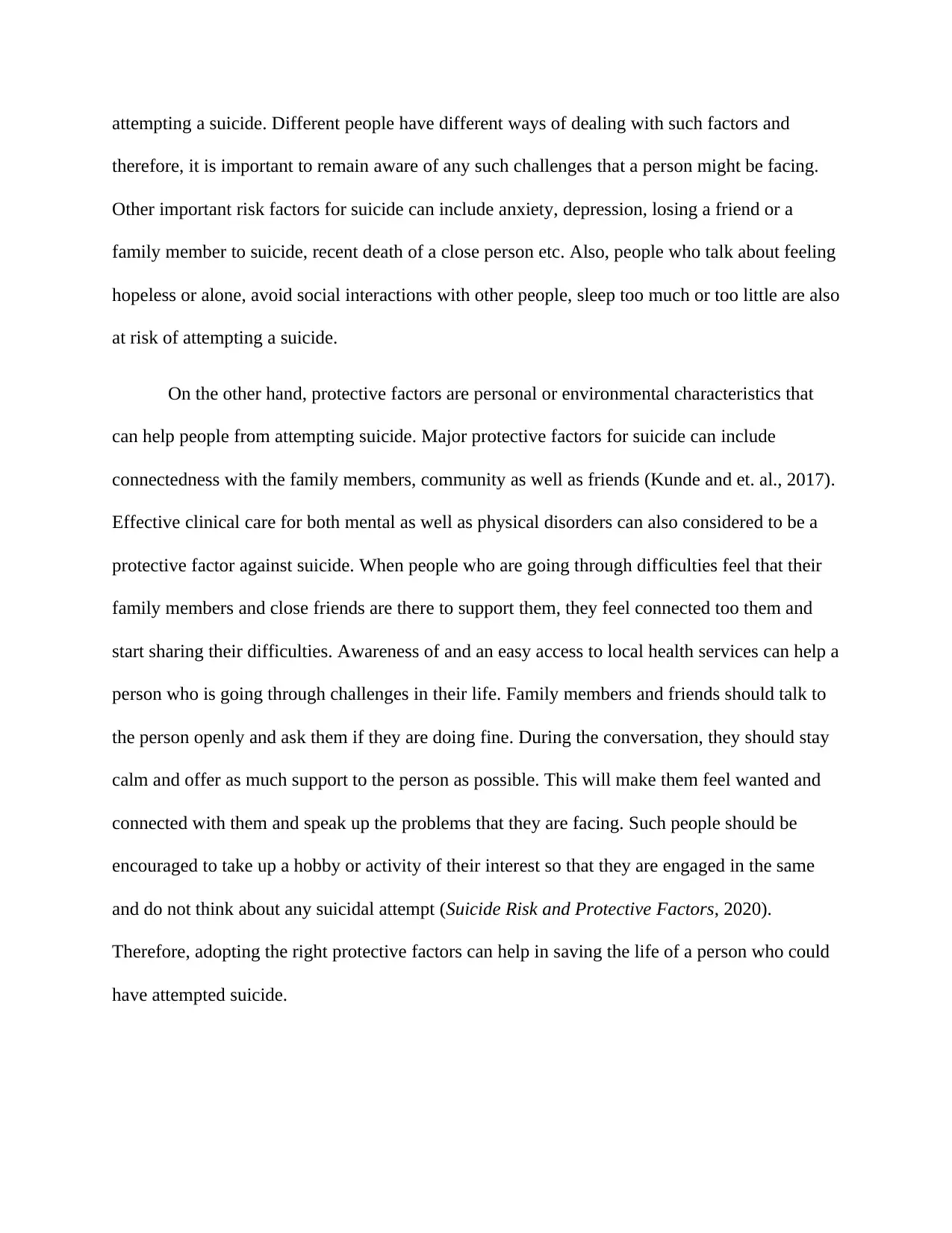
attempting a suicide. Different people have different ways of dealing with such factors and
therefore, it is important to remain aware of any such challenges that a person might be facing.
Other important risk factors for suicide can include anxiety, depression, losing a friend or a
family member to suicide, recent death of a close person etc. Also, people who talk about feeling
hopeless or alone, avoid social interactions with other people, sleep too much or too little are also
at risk of attempting a suicide.
On the other hand, protective factors are personal or environmental characteristics that
can help people from attempting suicide. Major protective factors for suicide can include
connectedness with the family members, community as well as friends (Kunde and et. al., 2017).
Effective clinical care for both mental as well as physical disorders can also considered to be a
protective factor against suicide. When people who are going through difficulties feel that their
family members and close friends are there to support them, they feel connected too them and
start sharing their difficulties. Awareness of and an easy access to local health services can help a
person who is going through challenges in their life. Family members and friends should talk to
the person openly and ask them if they are doing fine. During the conversation, they should stay
calm and offer as much support to the person as possible. This will make them feel wanted and
connected with them and speak up the problems that they are facing. Such people should be
encouraged to take up a hobby or activity of their interest so that they are engaged in the same
and do not think about any suicidal attempt (Suicide Risk and Protective Factors, 2020).
Therefore, adopting the right protective factors can help in saving the life of a person who could
have attempted suicide.
therefore, it is important to remain aware of any such challenges that a person might be facing.
Other important risk factors for suicide can include anxiety, depression, losing a friend or a
family member to suicide, recent death of a close person etc. Also, people who talk about feeling
hopeless or alone, avoid social interactions with other people, sleep too much or too little are also
at risk of attempting a suicide.
On the other hand, protective factors are personal or environmental characteristics that
can help people from attempting suicide. Major protective factors for suicide can include
connectedness with the family members, community as well as friends (Kunde and et. al., 2017).
Effective clinical care for both mental as well as physical disorders can also considered to be a
protective factor against suicide. When people who are going through difficulties feel that their
family members and close friends are there to support them, they feel connected too them and
start sharing their difficulties. Awareness of and an easy access to local health services can help a
person who is going through challenges in their life. Family members and friends should talk to
the person openly and ask them if they are doing fine. During the conversation, they should stay
calm and offer as much support to the person as possible. This will make them feel wanted and
connected with them and speak up the problems that they are facing. Such people should be
encouraged to take up a hobby or activity of their interest so that they are engaged in the same
and do not think about any suicidal attempt (Suicide Risk and Protective Factors, 2020).
Therefore, adopting the right protective factors can help in saving the life of a person who could
have attempted suicide.
⊘ This is a preview!⊘
Do you want full access?
Subscribe today to unlock all pages.

Trusted by 1+ million students worldwide
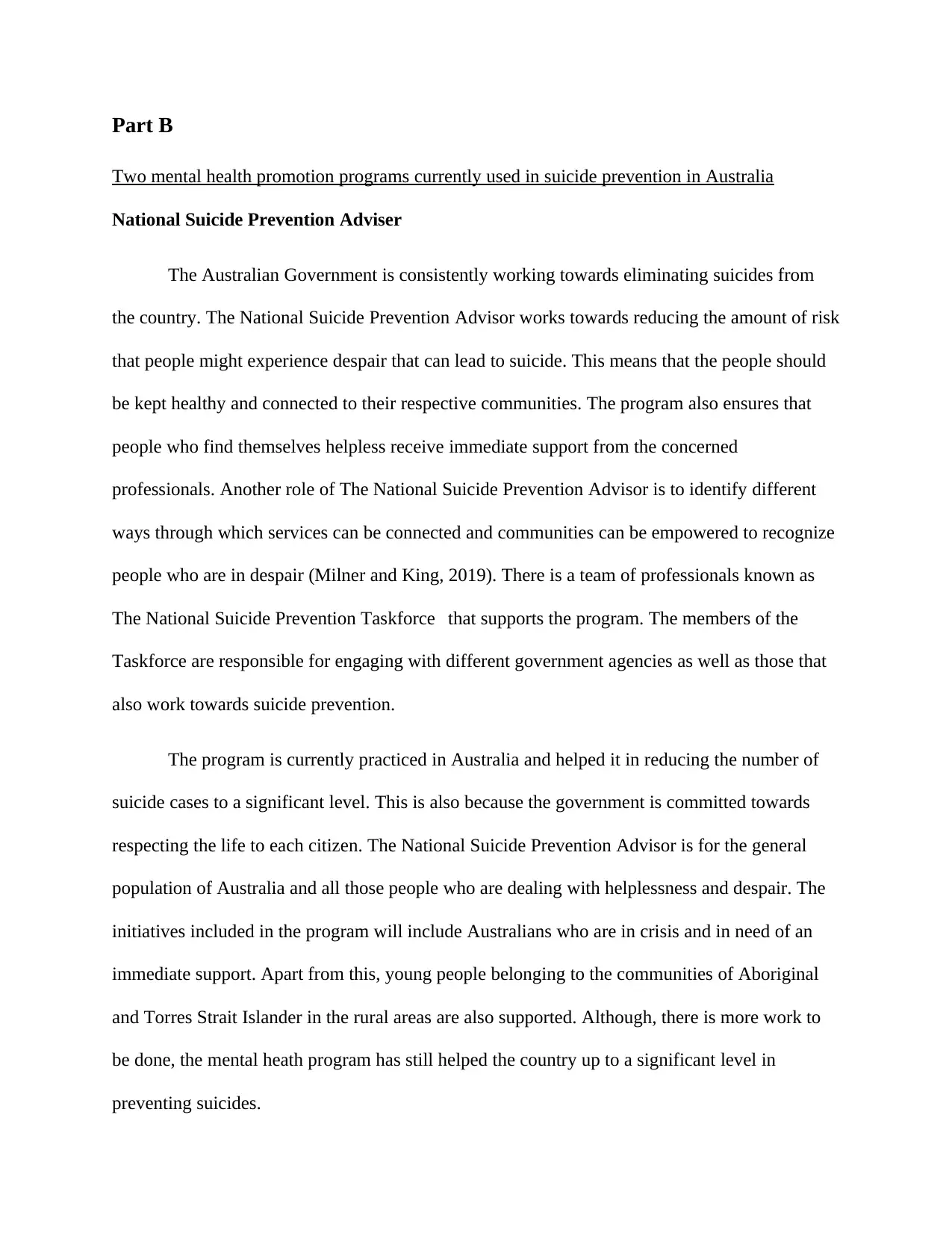
Part B
Two mental health promotion programs currently used in suicide prevention in Australia
National Suicide Prevention Adviser
The Australian Government is consistently working towards eliminating suicides from
the country. The National Suicide Prevention Advisor works towards reducing the amount of risk
that people might experience despair that can lead to suicide. This means that the people should
be kept healthy and connected to their respective communities. The program also ensures that
people who find themselves helpless receive immediate support from the concerned
professionals. Another role of The National Suicide Prevention Advisor is to identify different
ways through which services can be connected and communities can be empowered to recognize
people who are in despair (Milner and King, 2019). There is a team of professionals known as
The National Suicide Prevention Taskforce that supports the program. The members of the
Taskforce are responsible for engaging with different government agencies as well as those that
also work towards suicide prevention.
The program is currently practiced in Australia and helped it in reducing the number of
suicide cases to a significant level. This is also because the government is committed towards
respecting the life to each citizen. The National Suicide Prevention Advisor is for the general
population of Australia and all those people who are dealing with helplessness and despair. The
initiatives included in the program will include Australians who are in crisis and in need of an
immediate support. Apart from this, young people belonging to the communities of Aboriginal
and Torres Strait Islander in the rural areas are also supported. Although, there is more work to
be done, the mental heath program has still helped the country up to a significant level in
preventing suicides.
Two mental health promotion programs currently used in suicide prevention in Australia
National Suicide Prevention Adviser
The Australian Government is consistently working towards eliminating suicides from
the country. The National Suicide Prevention Advisor works towards reducing the amount of risk
that people might experience despair that can lead to suicide. This means that the people should
be kept healthy and connected to their respective communities. The program also ensures that
people who find themselves helpless receive immediate support from the concerned
professionals. Another role of The National Suicide Prevention Advisor is to identify different
ways through which services can be connected and communities can be empowered to recognize
people who are in despair (Milner and King, 2019). There is a team of professionals known as
The National Suicide Prevention Taskforce that supports the program. The members of the
Taskforce are responsible for engaging with different government agencies as well as those that
also work towards suicide prevention.
The program is currently practiced in Australia and helped it in reducing the number of
suicide cases to a significant level. This is also because the government is committed towards
respecting the life to each citizen. The National Suicide Prevention Advisor is for the general
population of Australia and all those people who are dealing with helplessness and despair. The
initiatives included in the program will include Australians who are in crisis and in need of an
immediate support. Apart from this, young people belonging to the communities of Aboriginal
and Torres Strait Islander in the rural areas are also supported. Although, there is more work to
be done, the mental heath program has still helped the country up to a significant level in
preventing suicides.
Paraphrase This Document
Need a fresh take? Get an instant paraphrase of this document with our AI Paraphraser
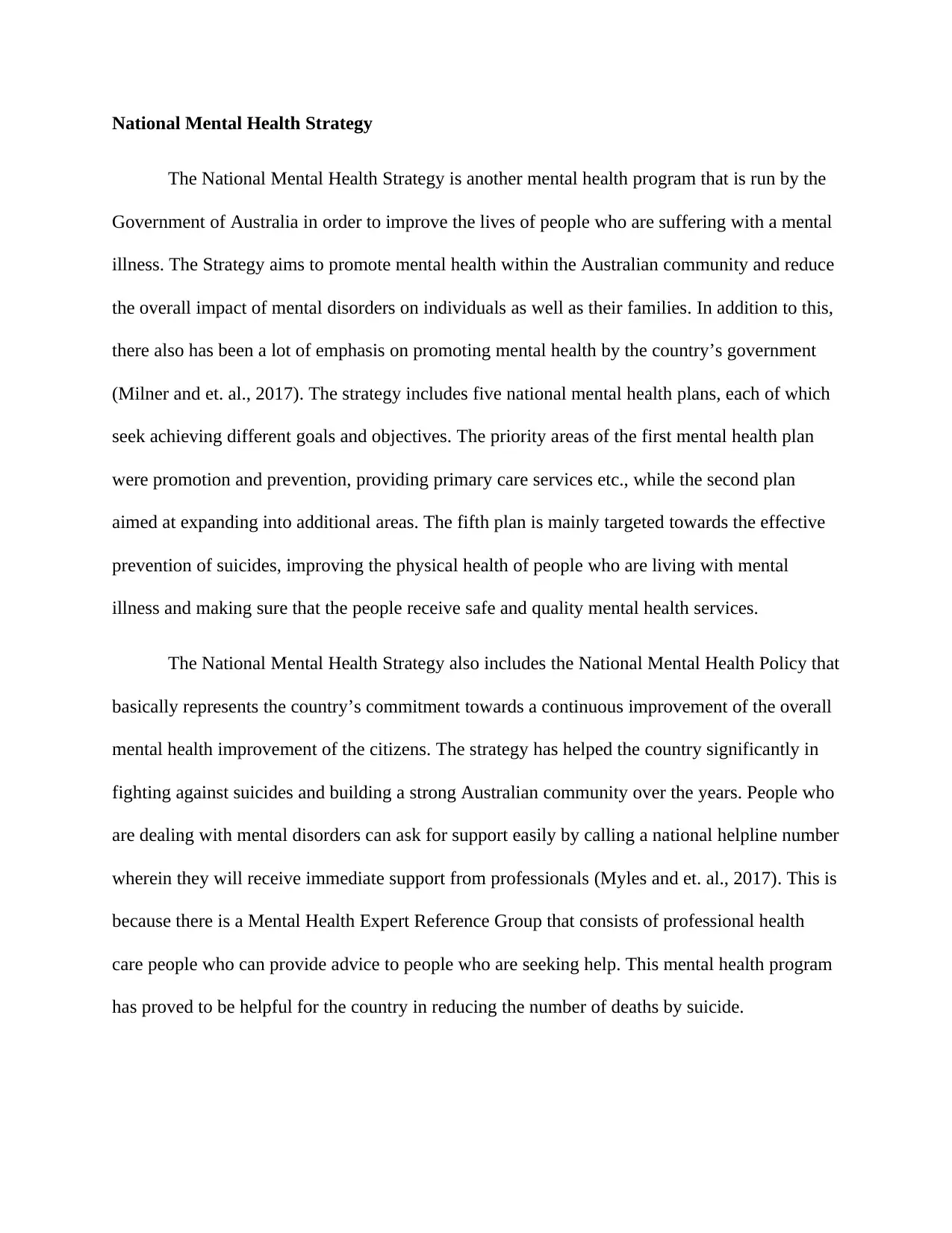
National Mental Health Strategy
The National Mental Health Strategy is another mental health program that is run by the
Government of Australia in order to improve the lives of people who are suffering with a mental
illness. The Strategy aims to promote mental health within the Australian community and reduce
the overall impact of mental disorders on individuals as well as their families. In addition to this,
there also has been a lot of emphasis on promoting mental health by the country’s government
(Milner and et. al., 2017). The strategy includes five national mental health plans, each of which
seek achieving different goals and objectives. The priority areas of the first mental health plan
were promotion and prevention, providing primary care services etc., while the second plan
aimed at expanding into additional areas. The fifth plan is mainly targeted towards the effective
prevention of suicides, improving the physical health of people who are living with mental
illness and making sure that the people receive safe and quality mental health services.
The National Mental Health Strategy also includes the National Mental Health Policy that
basically represents the country’s commitment towards a continuous improvement of the overall
mental health improvement of the citizens. The strategy has helped the country significantly in
fighting against suicides and building a strong Australian community over the years. People who
are dealing with mental disorders can ask for support easily by calling a national helpline number
wherein they will receive immediate support from professionals (Myles and et. al., 2017). This is
because there is a Mental Health Expert Reference Group that consists of professional health
care people who can provide advice to people who are seeking help. This mental health program
has proved to be helpful for the country in reducing the number of deaths by suicide.
The National Mental Health Strategy is another mental health program that is run by the
Government of Australia in order to improve the lives of people who are suffering with a mental
illness. The Strategy aims to promote mental health within the Australian community and reduce
the overall impact of mental disorders on individuals as well as their families. In addition to this,
there also has been a lot of emphasis on promoting mental health by the country’s government
(Milner and et. al., 2017). The strategy includes five national mental health plans, each of which
seek achieving different goals and objectives. The priority areas of the first mental health plan
were promotion and prevention, providing primary care services etc., while the second plan
aimed at expanding into additional areas. The fifth plan is mainly targeted towards the effective
prevention of suicides, improving the physical health of people who are living with mental
illness and making sure that the people receive safe and quality mental health services.
The National Mental Health Strategy also includes the National Mental Health Policy that
basically represents the country’s commitment towards a continuous improvement of the overall
mental health improvement of the citizens. The strategy has helped the country significantly in
fighting against suicides and building a strong Australian community over the years. People who
are dealing with mental disorders can ask for support easily by calling a national helpline number
wherein they will receive immediate support from professionals (Myles and et. al., 2017). This is
because there is a Mental Health Expert Reference Group that consists of professional health
care people who can provide advice to people who are seeking help. This mental health program
has proved to be helpful for the country in reducing the number of deaths by suicide.
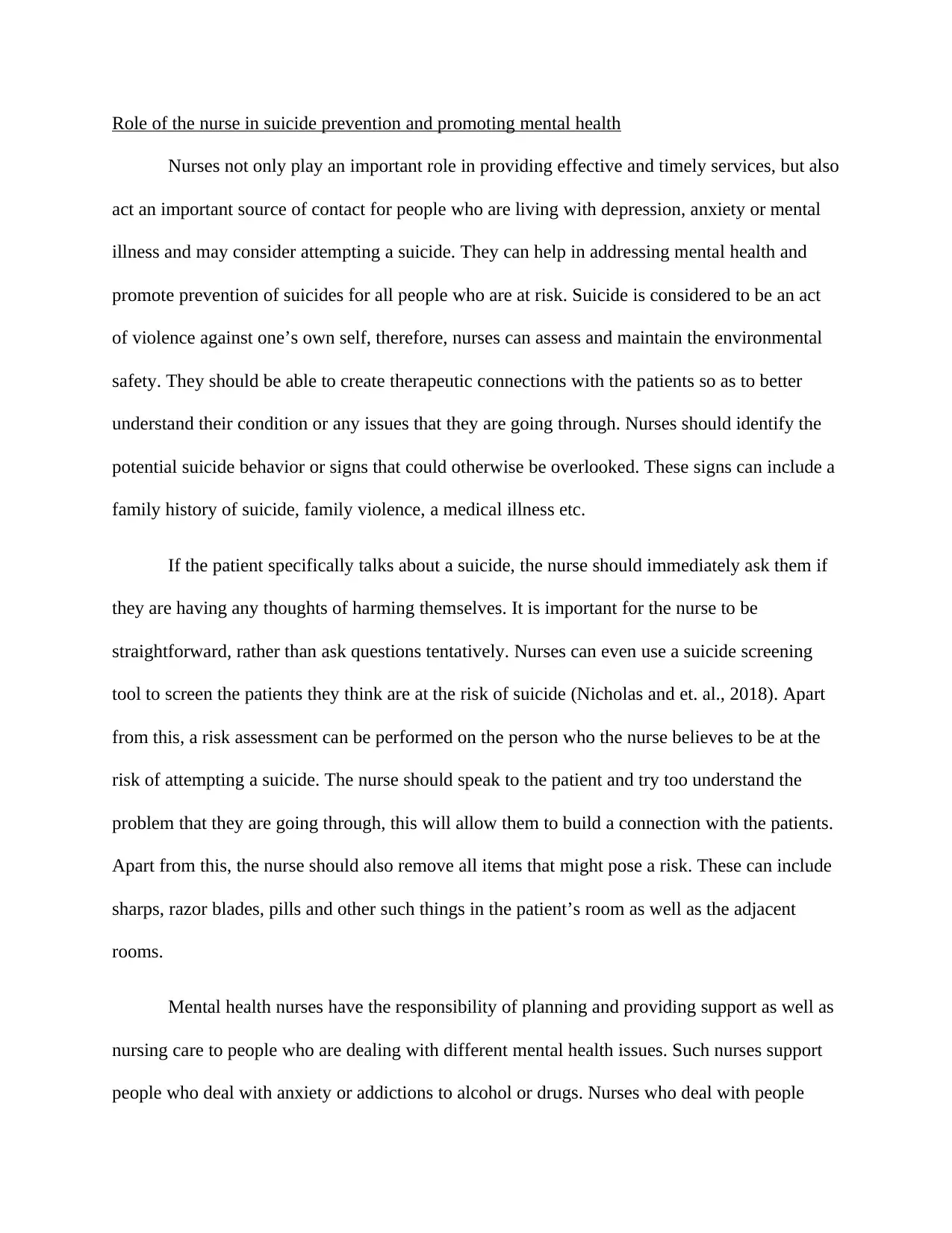
Role of the nurse in suicide prevention and promoting mental health
Nurses not only play an important role in providing effective and timely services, but also
act an important source of contact for people who are living with depression, anxiety or mental
illness and may consider attempting a suicide. They can help in addressing mental health and
promote prevention of suicides for all people who are at risk. Suicide is considered to be an act
of violence against one’s own self, therefore, nurses can assess and maintain the environmental
safety. They should be able to create therapeutic connections with the patients so as to better
understand their condition or any issues that they are going through. Nurses should identify the
potential suicide behavior or signs that could otherwise be overlooked. These signs can include a
family history of suicide, family violence, a medical illness etc.
If the patient specifically talks about a suicide, the nurse should immediately ask them if
they are having any thoughts of harming themselves. It is important for the nurse to be
straightforward, rather than ask questions tentatively. Nurses can even use a suicide screening
tool to screen the patients they think are at the risk of suicide (Nicholas and et. al., 2018). Apart
from this, a risk assessment can be performed on the person who the nurse believes to be at the
risk of attempting a suicide. The nurse should speak to the patient and try too understand the
problem that they are going through, this will allow them to build a connection with the patients.
Apart from this, the nurse should also remove all items that might pose a risk. These can include
sharps, razor blades, pills and other such things in the patient’s room as well as the adjacent
rooms.
Mental health nurses have the responsibility of planning and providing support as well as
nursing care to people who are dealing with different mental health issues. Such nurses support
people who deal with anxiety or addictions to alcohol or drugs. Nurses who deal with people
Nurses not only play an important role in providing effective and timely services, but also
act an important source of contact for people who are living with depression, anxiety or mental
illness and may consider attempting a suicide. They can help in addressing mental health and
promote prevention of suicides for all people who are at risk. Suicide is considered to be an act
of violence against one’s own self, therefore, nurses can assess and maintain the environmental
safety. They should be able to create therapeutic connections with the patients so as to better
understand their condition or any issues that they are going through. Nurses should identify the
potential suicide behavior or signs that could otherwise be overlooked. These signs can include a
family history of suicide, family violence, a medical illness etc.
If the patient specifically talks about a suicide, the nurse should immediately ask them if
they are having any thoughts of harming themselves. It is important for the nurse to be
straightforward, rather than ask questions tentatively. Nurses can even use a suicide screening
tool to screen the patients they think are at the risk of suicide (Nicholas and et. al., 2018). Apart
from this, a risk assessment can be performed on the person who the nurse believes to be at the
risk of attempting a suicide. The nurse should speak to the patient and try too understand the
problem that they are going through, this will allow them to build a connection with the patients.
Apart from this, the nurse should also remove all items that might pose a risk. These can include
sharps, razor blades, pills and other such things in the patient’s room as well as the adjacent
rooms.
Mental health nurses have the responsibility of planning and providing support as well as
nursing care to people who are dealing with different mental health issues. Such nurses support
people who deal with anxiety or addictions to alcohol or drugs. Nurses who deal with people
⊘ This is a preview!⊘
Do you want full access?
Subscribe today to unlock all pages.

Trusted by 1+ million students worldwide
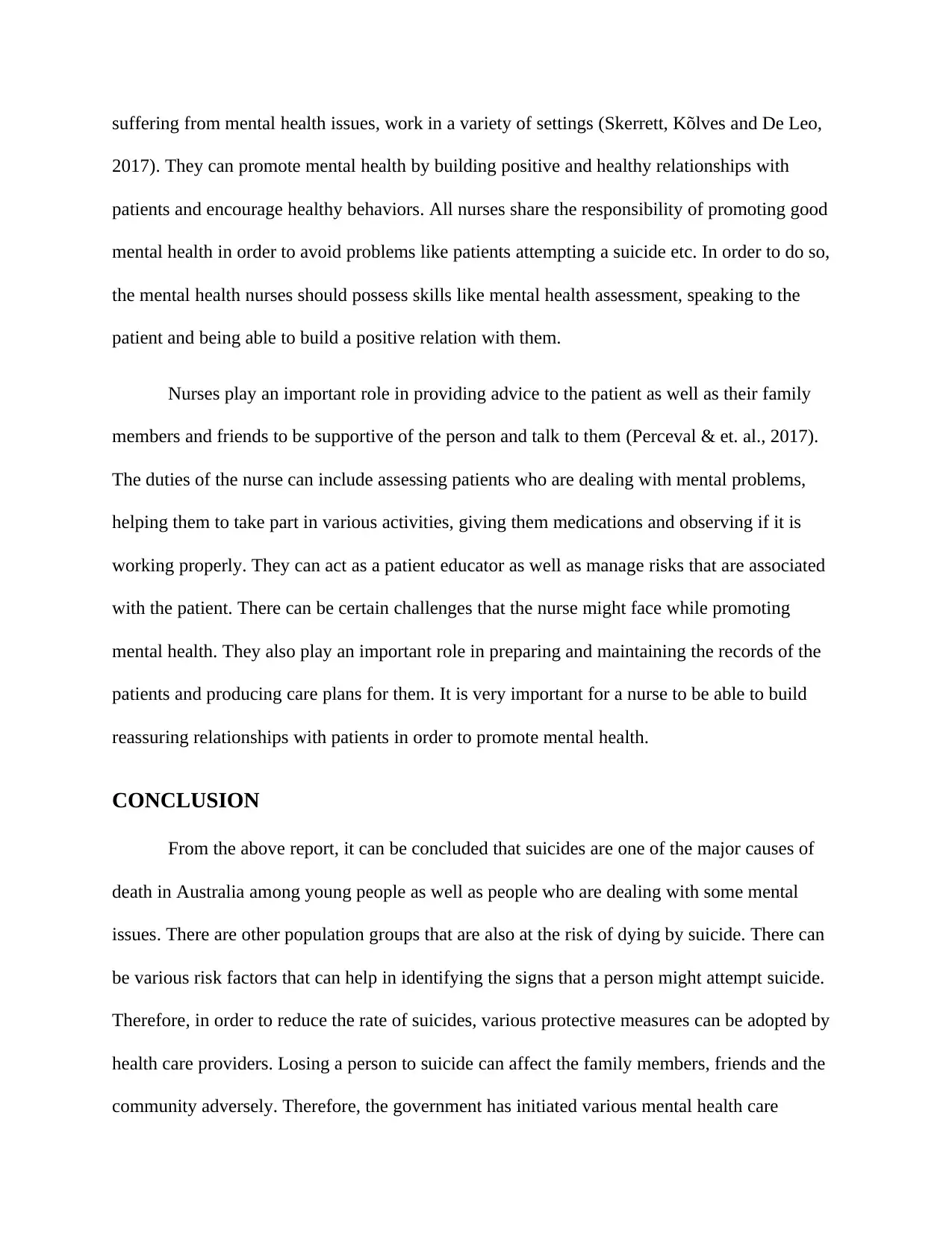
suffering from mental health issues, work in a variety of settings (Skerrett, Kõlves and De Leo,
2017). They can promote mental health by building positive and healthy relationships with
patients and encourage healthy behaviors. All nurses share the responsibility of promoting good
mental health in order to avoid problems like patients attempting a suicide etc. In order to do so,
the mental health nurses should possess skills like mental health assessment, speaking to the
patient and being able to build a positive relation with them.
Nurses play an important role in providing advice to the patient as well as their family
members and friends to be supportive of the person and talk to them (Perceval & et. al., 2017).
The duties of the nurse can include assessing patients who are dealing with mental problems,
helping them to take part in various activities, giving them medications and observing if it is
working properly. They can act as a patient educator as well as manage risks that are associated
with the patient. There can be certain challenges that the nurse might face while promoting
mental health. They also play an important role in preparing and maintaining the records of the
patients and producing care plans for them. It is very important for a nurse to be able to build
reassuring relationships with patients in order to promote mental health.
CONCLUSION
From the above report, it can be concluded that suicides are one of the major causes of
death in Australia among young people as well as people who are dealing with some mental
issues. There are other population groups that are also at the risk of dying by suicide. There can
be various risk factors that can help in identifying the signs that a person might attempt suicide.
Therefore, in order to reduce the rate of suicides, various protective measures can be adopted by
health care providers. Losing a person to suicide can affect the family members, friends and the
community adversely. Therefore, the government has initiated various mental health care
2017). They can promote mental health by building positive and healthy relationships with
patients and encourage healthy behaviors. All nurses share the responsibility of promoting good
mental health in order to avoid problems like patients attempting a suicide etc. In order to do so,
the mental health nurses should possess skills like mental health assessment, speaking to the
patient and being able to build a positive relation with them.
Nurses play an important role in providing advice to the patient as well as their family
members and friends to be supportive of the person and talk to them (Perceval & et. al., 2017).
The duties of the nurse can include assessing patients who are dealing with mental problems,
helping them to take part in various activities, giving them medications and observing if it is
working properly. They can act as a patient educator as well as manage risks that are associated
with the patient. There can be certain challenges that the nurse might face while promoting
mental health. They also play an important role in preparing and maintaining the records of the
patients and producing care plans for them. It is very important for a nurse to be able to build
reassuring relationships with patients in order to promote mental health.
CONCLUSION
From the above report, it can be concluded that suicides are one of the major causes of
death in Australia among young people as well as people who are dealing with some mental
issues. There are other population groups that are also at the risk of dying by suicide. There can
be various risk factors that can help in identifying the signs that a person might attempt suicide.
Therefore, in order to reduce the rate of suicides, various protective measures can be adopted by
health care providers. Losing a person to suicide can affect the family members, friends and the
community adversely. Therefore, the government has initiated various mental health care
Paraphrase This Document
Need a fresh take? Get an instant paraphrase of this document with our AI Paraphraser

programs that can help in bringing down the number of suicides. The nurses also play an
important role in promoting good mental health.
important role in promoting good mental health.
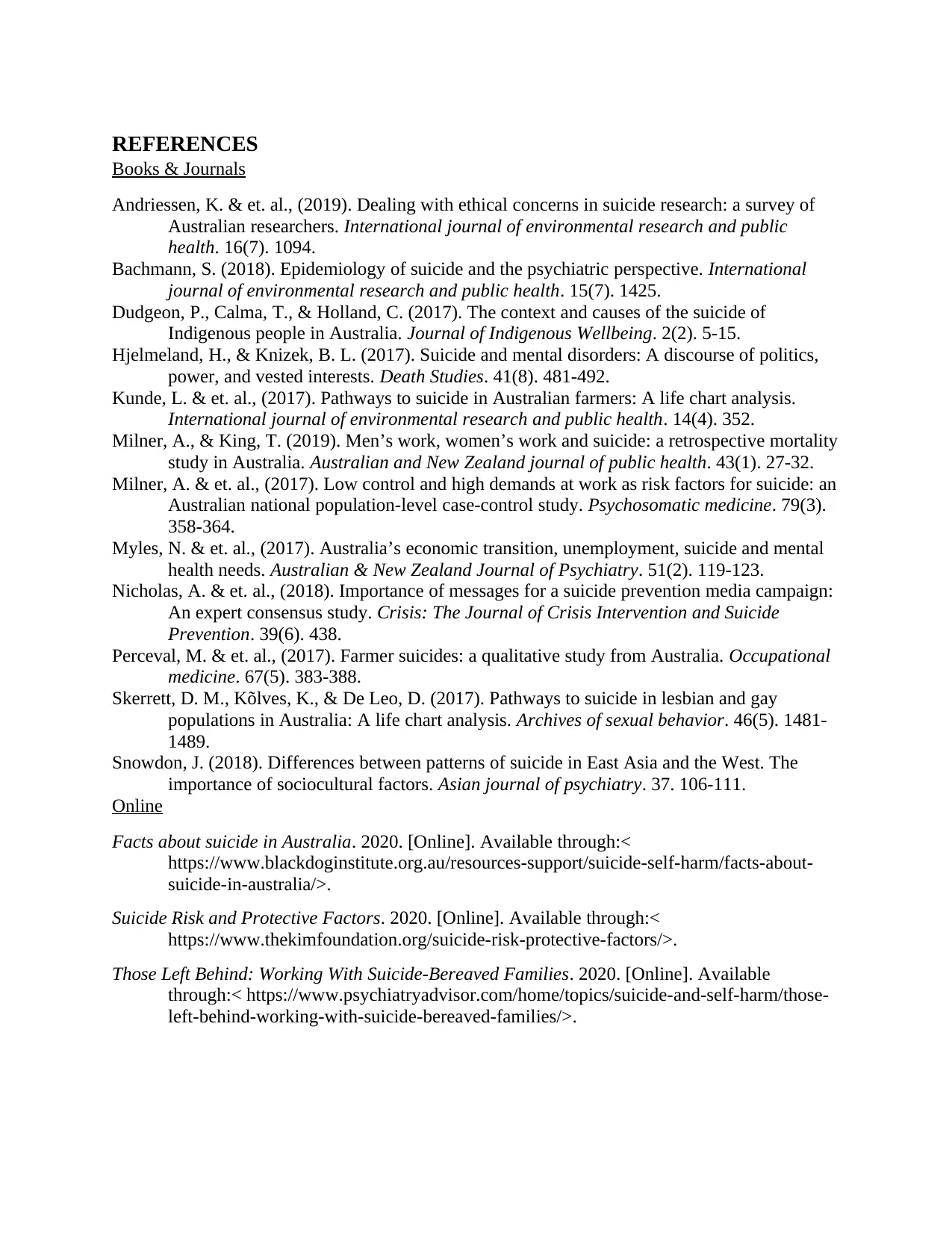
REFERENCES
Books & Journals
Andriessen, K. & et. al., (2019). Dealing with ethical concerns in suicide research: a survey of
Australian researchers. International journal of environmental research and public
health. 16(7). 1094.
Bachmann, S. (2018). Epidemiology of suicide and the psychiatric perspective. International
journal of environmental research and public health. 15(7). 1425.
Dudgeon, P., Calma, T., & Holland, C. (2017). The context and causes of the suicide of
Indigenous people in Australia. Journal of Indigenous Wellbeing. 2(2). 5-15.
Hjelmeland, H., & Knizek, B. L. (2017). Suicide and mental disorders: A discourse of politics,
power, and vested interests. Death Studies. 41(8). 481-492.
Kunde, L. & et. al., (2017). Pathways to suicide in Australian farmers: A life chart analysis.
International journal of environmental research and public health. 14(4). 352.
Milner, A., & King, T. (2019). Men’s work, women’s work and suicide: a retrospective mortality
study in Australia. Australian and New Zealand journal of public health. 43(1). 27-32.
Milner, A. & et. al., (2017). Low control and high demands at work as risk factors for suicide: an
Australian national population-level case-control study. Psychosomatic medicine. 79(3).
358-364.
Myles, N. & et. al., (2017). Australia’s economic transition, unemployment, suicide and mental
health needs. Australian & New Zealand Journal of Psychiatry. 51(2). 119-123.
Nicholas, A. & et. al., (2018). Importance of messages for a suicide prevention media campaign:
An expert consensus study. Crisis: The Journal of Crisis Intervention and Suicide
Prevention. 39(6). 438.
Perceval, M. & et. al., (2017). Farmer suicides: a qualitative study from Australia. Occupational
medicine. 67(5). 383-388.
Skerrett, D. M., Kõlves, K., & De Leo, D. (2017). Pathways to suicide in lesbian and gay
populations in Australia: A life chart analysis. Archives of sexual behavior. 46(5). 1481-
1489.
Snowdon, J. (2018). Differences between patterns of suicide in East Asia and the West. The
importance of sociocultural factors. Asian journal of psychiatry. 37. 106-111.
Online
Facts about suicide in Australia. 2020. [Online]. Available through:<
https://www.blackdoginstitute.org.au/resources-support/suicide-self-harm/facts-about-
suicide-in-australia/>.
Suicide Risk and Protective Factors. 2020. [Online]. Available through:<
https://www.thekimfoundation.org/suicide-risk-protective-factors/>.
Those Left Behind: Working With Suicide-Bereaved Families. 2020. [Online]. Available
through:< https://www.psychiatryadvisor.com/home/topics/suicide-and-self-harm/those-
left-behind-working-with-suicide-bereaved-families/>.
Books & Journals
Andriessen, K. & et. al., (2019). Dealing with ethical concerns in suicide research: a survey of
Australian researchers. International journal of environmental research and public
health. 16(7). 1094.
Bachmann, S. (2018). Epidemiology of suicide and the psychiatric perspective. International
journal of environmental research and public health. 15(7). 1425.
Dudgeon, P., Calma, T., & Holland, C. (2017). The context and causes of the suicide of
Indigenous people in Australia. Journal of Indigenous Wellbeing. 2(2). 5-15.
Hjelmeland, H., & Knizek, B. L. (2017). Suicide and mental disorders: A discourse of politics,
power, and vested interests. Death Studies. 41(8). 481-492.
Kunde, L. & et. al., (2017). Pathways to suicide in Australian farmers: A life chart analysis.
International journal of environmental research and public health. 14(4). 352.
Milner, A., & King, T. (2019). Men’s work, women’s work and suicide: a retrospective mortality
study in Australia. Australian and New Zealand journal of public health. 43(1). 27-32.
Milner, A. & et. al., (2017). Low control and high demands at work as risk factors for suicide: an
Australian national population-level case-control study. Psychosomatic medicine. 79(3).
358-364.
Myles, N. & et. al., (2017). Australia’s economic transition, unemployment, suicide and mental
health needs. Australian & New Zealand Journal of Psychiatry. 51(2). 119-123.
Nicholas, A. & et. al., (2018). Importance of messages for a suicide prevention media campaign:
An expert consensus study. Crisis: The Journal of Crisis Intervention and Suicide
Prevention. 39(6). 438.
Perceval, M. & et. al., (2017). Farmer suicides: a qualitative study from Australia. Occupational
medicine. 67(5). 383-388.
Skerrett, D. M., Kõlves, K., & De Leo, D. (2017). Pathways to suicide in lesbian and gay
populations in Australia: A life chart analysis. Archives of sexual behavior. 46(5). 1481-
1489.
Snowdon, J. (2018). Differences between patterns of suicide in East Asia and the West. The
importance of sociocultural factors. Asian journal of psychiatry. 37. 106-111.
Online
Facts about suicide in Australia. 2020. [Online]. Available through:<
https://www.blackdoginstitute.org.au/resources-support/suicide-self-harm/facts-about-
suicide-in-australia/>.
Suicide Risk and Protective Factors. 2020. [Online]. Available through:<
https://www.thekimfoundation.org/suicide-risk-protective-factors/>.
Those Left Behind: Working With Suicide-Bereaved Families. 2020. [Online]. Available
through:< https://www.psychiatryadvisor.com/home/topics/suicide-and-self-harm/those-
left-behind-working-with-suicide-bereaved-families/>.
⊘ This is a preview!⊘
Do you want full access?
Subscribe today to unlock all pages.

Trusted by 1+ million students worldwide
1 out of 12
Related Documents
Your All-in-One AI-Powered Toolkit for Academic Success.
+13062052269
info@desklib.com
Available 24*7 on WhatsApp / Email
![[object Object]](/_next/static/media/star-bottom.7253800d.svg)
Unlock your academic potential
Copyright © 2020–2025 A2Z Services. All Rights Reserved. Developed and managed by ZUCOL.





